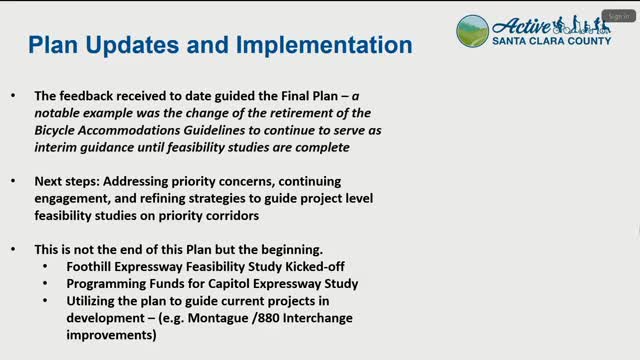Santa Clara County Roads Commission approves Active Transportation Plan for San Jose VTA project
April 18, 2025 | Santa Clara County, California
Thanks to Scribe from Workplace AI and Family Portal , all articles about California are free for you to enjoy throughout 2025!

This article was created by AI using a video recording of the meeting. It summarizes the key points discussed, but for full details and context, please refer to the video of the full meeting. Link to Full Meeting
The ATP, which is currently in draft form, has already garnered unanimous support from the Santa Clara County Roads Commission. This approval was obtained after a presentation on March 19, 2025, and was followed by a review from the Valley Transportation Authority's Bicycle and Pedestrian Advisory Committee (VTA BPAC) on April 9, 2025. The VTA BPAC provided eight conditions for the plan, focusing on necessary modifications to ensure the safety and accessibility of biking and walking routes.
County officials highlighted that the ATP will serve as a foundational document to guide future projects and grant applications, emphasizing its role in securing funding for critical infrastructure improvements. The next step involves presenting the plan to the Board of Supervisors for formal adoption, anticipated between May and June 2025.
Public comments during the meeting reflected a mix of support and concerns. Several speakers praised the plan for its potential to improve safety for cyclists and pedestrians, while others raised issues regarding equity and the historical context of transportation policies in the region. Notably, some community members expressed disappointment over the lack of consultation with local bicycle and pedestrian advisory committees during the plan's development.
As the county prepares for the final adoption of the ATP, stakeholders remain hopeful that the plan will lead to safer, more accessible transportation options for all residents, particularly in underserved areas. The ongoing discussions underscore the importance of community engagement in shaping transportation policies that meet the needs of diverse populations.
Converted from Housing, Land Use, Environment, & Transportation Committee April 17, 2025 10:00 a.m. meeting on April 18, 2025
Link to Full Meeting
Comments
View full meeting
This article is based on a recent meeting—watch the full video and explore the complete transcript for deeper insights into the discussion.
View full meeting